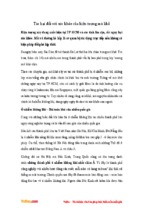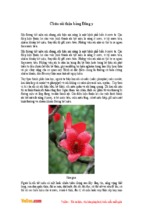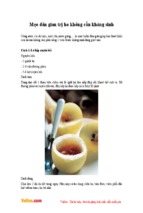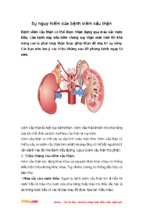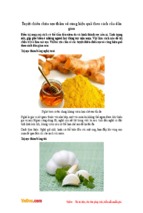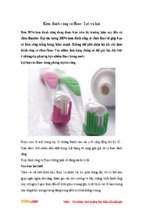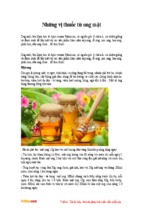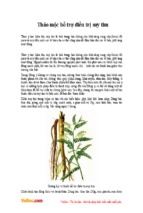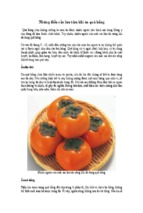A Flora of Shrewsbury
Sarah J. Whild, Martin F. Godfrey and Alexander J. Lockton
2011
Shropshire Botanical Society & the University of Birmingham
With contributions by Helen Critchley, Elizabeth Dale, Mark Duffell, Sally Garrington, Amelia Grant, Pam
Green, Llewellyn Guest, John Handley, Maurice Hoare, Charlotte Hosie, Heather Jackson, Ray Knowles,
Marjorie Leonard, Rachel Meade, Jane Morris, Rose Parker, Jan Pursaill, Juliet Ramsbotham, Jo Thompson, Ian
Thompson, Rosemary Thornes, Gill Wilson & Penny Wysome.
0
A Flora of Shrewsbury
An annotated checklist of the vascular plants, bryophytes and charophytes of the town of Shrewsbury, based on
fieldwork conducted by the University of Birmingham School of Biosciences, with the Shropshire Botanical
Society, in 2010.
By Sarah Whild, Martin Godfrey & Alex Lockton
With contributions by Helen Critchley, Elizabeth Dale, Mark Duffell, Sally Garrington, Amelia Grant, Pam
Green, Llewellyn Guest, John Handley, Maurice Hoare, Charlotte Hosie, Heather Jackson, Ray Knowles,
Marjorie Leonard, Rachel Meade, Jane Morris, Rose Parker, Jan Pursaill, Juliet Ramsbotham, Jo Thompson, Ian
Thompson, Rosemary Thornes, Gill Wilson & Penny Wysome.
Shropshire Botanical Society & the University of Birmingham
The University of Birmingham
The Gateway Arts & Educational Centre
Chester Street
Shrewsbury
Shropshire
SY1 1NB
2011
Photographs by A.J. Lockton and M.F. Godfrey (bryophytes).
All rights reserved.
© Sarah Whild & Alex Lockton, 2011
OS Licence No. 100040428 (Shropshire Botanical Society).
This report is unpublished but is freely available in electronic format via the web site of the Botanical Society of
the British Isles, www.bsbi.org.uk. Readers are welcome to download it and reproduce it in electronic or printed
form, and distribute it as they wish, provided no charge or financial gain is made and no changes are made to the
contents. The right to reproduce the Ordnance Survey map is subject to the regulations of that organisation.
Cover photograph: River Severn and Laura’s Tower.
In memory of Melody Ryle (1917-2007) who lived in Shrewsbury and enjoyed the local flora for sixty years.
1
Introduction
Shrewsbury is the most botanically diverse part of Shropshire, with 665 species of vascular plants recorded in its
central tetrad (2 km x 2 km square). This is partly due to a long history of intensive recording and partly due to
the diversity of the area, with semi-natural places occurring adjacent to the artificial habitats and disturbance
associated with human activity. This makes it a good place to explore and study plant identification, which was
our main purpose with this Flora. As in Frank Perring’s 1975 Flora of Attingham Park, we ran a series of
identification days around the town and encouraged the participants to explore other areas independently.
Records were collected for the sake of thoroughness and, while they can be used for purposes such as studying
distribution and change, that is not directly relevant to this study. Shrewsbury is not a nature reserve and
management of even its wild areas is largely uninfluenced by conservation. Most wildlife that exists here does
so entirely of its own accord.
The area covered is the land within the river loop that makes up the historical town of Shrewsbury, plus areas on
the opposite side of the river, in the squares SJ4812 and SJ4912. Where Burr’s Field strays into two adjacent km
squares, these bits are included, too. The survey was intended to record wild species, not planted ones, but the
dividing line is unclear and we have erred on the side of including more rather than less. In particular, we have
recorded some planted trees when they are in wilder places, and anything that looks like it might be spreading.
The survey took place throughout 2010 but the species accounts include all records for Shrewsbury from the
Shropshire Flora Database. Hopefully it is made clear as to which species were found during this survey and
which appear to have become extinct. New records are marked with an asterisk and those which are considered
to be extinct are marked thus †.
The species accounts are arranged in taxonomic order but there is an index so a particular species can be looked
up. Common names are also given in the species accounts and both common and scientific names are given in
the review of sites. Only scientific names are given in the review of historical records. Scientific names for
vascular plants are taken from Stace (2010) and bryophyte names
are taken from the current British Bryological Society checklist,
available on their web site at www.britishbryologicalsociety.org.uk.
Changes in the Flora
There are 106 species that have not been re-recorded in this survey
and have not been recorded in the preceding decade so it is
reasonable to consider these to be extinct from the Shrewsbury
survey area. All extinctions are marked † and will not have been
recorded since 2001 or will be from a site that is known to
have been destroyed. Of these extinctions, 8 are bryophytes
and the remainder are vascular plants.
There are 77 new species that have not been recorded for
Shrewsbury before this survey and they are marked with an
asterisk (*). This is not an ecological Site Flora, so analysis
of the changes would reveal little that is not already well
known about urbanisation, climate change and the
proliferation of some non-native species. It could, however,
shed light on the ecology of certain species, such as
Campanula patula (Spreading Bellflower), which seems to
have been associated with roadsides and river banks in the
past, and may have declined because of changes in modes of
transport.
Campanula patula in Shropshire. Yellow dots
are for old records (pre-1985)
2
Recording in Shrewsbury
The earliest known records for Shrewsbury are by J.J. Dillenius, professor of botany at Oxford, in 1726, when
he recorded Fumaria purpurea (Purple Ramping-fumitory) and Limosella aquatica (Mudwort) in or near the
town. This was before the weir was constructed, so the river would have been shallower and muddier. In 1793,
when the freelance Quaker scientist Arthur Aikin arrived in Shrewsbury, he found Oxalis corniculata
(Procumbent Yellow-sorrel) by the Welsh Bridge. He later recorded a fumitory (probably F. purpurea again) in
a hedge and Cochlearia danica (Danish Scurvygrass) on
the castle walls. The latter died out long ago but has
recently arrived in the town again along the edges of
salt-treated roads. In the 1790s and 1800s Edward
Williams made a few records around the town,
including the first for Smyrnium olusatrum at the castle
and three species of Rorippa (Yellow-cress) on the
riverbank. Williams was a vicar and an antiquarian, and
he was compiling the first Flora of the county but,
although he lived at nearby Coton Hill, he did not find
much in Shrewsbury to write about.
John Evans, senior physician at the Salop Infirmary,
made some records that were published in Turner &
Dillwyn’s Botanist’s Guide in 1805. These included an
unfortunate mistake in Geranium rotundifolium (Roundleaved Crane’s-bill), which Leighton and others have
puzzled over and written about. This southerly plant has
recently appeared of its own accord near Shrewsbury,
but it was also present in the vicinity of Leighton’s
garden for over a century, since he brought it in to see
what it looked like. Joseph Babington, a physician from
Ludlow, observed (in Plymley, 1803) that Echium
vulgare (Viper’s Bugloss) grew in sandy places near
Shrewsbury. A lot of the records for a town are, of
course, just incidental observations like these. Fumaria purpurea at the Slang
Systematic surveys are very unusual. The closest thing
to it is a Flora such as William Leighton’s Flora of 1841. Leighton recorded in a fairly structured way,
particularly around Shrewsbury, where he lived. He lists 139 species in and around the town, mostly records he
made himself between 1830 and 1841. He also sent many specimens off to botanical exchange clubs, and there
is still a wealth of valuable data to be extracted from herbaria in museums. Many of Leighton’s specimens are
now lodged at Shrewsbury Museum (SHY), which has been partially digitized by the Shropshire Botanical
Society.
Among Leighton’s contributions was a paper on a possible new species of violet that he found in Shrewsbury
(unfortunately not accepted by the experts), and three editions of a guide to the town of Shrewsbury, where he
mentions Diplotaxis tenuifolia (Perennial Wall-rocket) on the walls of the Abbey.
William Phillips was an energetic man with a diversity of interests who lived and worked in Shrewsbury and
published many records, especially in his ‘List of flowering plants and ferns within a radius of five miles round
Shrewsbury’ (Phillips 1878). Although this is tantalisingly close to being a valuable Site Flora and one of the
earliest ever, it is unfortunately of little use. There are few precise localities mentioned, and a 5 mile radius
encompasses a huge area. Worse still, he copied lots of Leighton’s records without attribution, so it is
impossible to tell what he really saw and what he merely repeated. We have had to disregard many of his
records, although of course he remains one of the town’s most important recorders, particularly of the
commoner species, and his are often the first and sometimes the only records. On the whole, his identifications
are not questioned, only his recording methods.
At about the same time as Phillips was active, Thomas Butler retired to Shrewsbury and undertook the curation
the museum herbarium, where he put numerous specimens he had collected in and around Shrewsbury.
Although he gave detailed locations of where he found the plants, he rarely put dates on the sheets, so we have
allocated them to the year he died (1886). In fact most are from the period 1868-1886.
In the 1880s William Beckwith published a few papers on the Flora of Shropshire and listed some plants for the
town. He particularly recorded aquatics in the river, which many people ignore. Also in the 1880s Richard
Benson collected specimens from Shrewsbury for his extensive herbarium, but he was only looking for oddities
3
that he could not get closer to home (Pulverbatch), so some of them are pretty obviously from gardens. He
eventually sold his collection to Shrewsbury School, who kindly made it available to us for photographing and
digitization. When it was loaded onto the web site Herbaria at Home, it had the distinction of being the first
complete virtual herbarium in the world.
In the first decade of the 20th century quite a few people recorded around town in preparation for William
Hamilton’s planned Flora, which was never published, but is still available for viewing in manuscript form in
the Shropshire Archive. It was at this time that the first bryophyte records were made, by Hamilton himself and
J.B. Duncan. The 1920s and 30s were a quiet period for botany, with just a few records by the retired millionaire
businessman James Cosmo Melvill and visits from famous botanists like George Claridge Druce. The only
records from the 1940s were by Norah Mackenzie and Miss S.M. Prideaux. It was not until the 1950s that
another serious attempt was made to do botanical recording, by Edward Rutter, a retired superintendent from the
L.N.E.R. He curated the museum herbarium and produced a checklist of plants of Shropshire, but he was more
interested in birds and most of his efforts went into founding the Shropshire Ornithological Society.
In the 1970s and 1980 recording was undertaken for Sinker’s Flora of Shropshire (1985), with a lot of work in
Shrewsbury undertaken by Helen Matthews. Since then there have been many site surveys and incidental
records. These are all included in the main list of records and, if they are unusual, the recorders’ names are
given.
List of recorders
A full list of recorders and referees, past and present, who have contributed records used in this report.
Mr A. Aikin
Mr W.B. Allen
Mr G.H. Ash
Mr S.J. Ayliffe
Rev J. Babington
Mr J. Ball
Mr J.S. Baly
Mr J. Baynes
Mr W. Beacall
Mr W.E. Beckwith
Rev Beddows
Mr K.K. Bell
Rev T.B. Bell
Mr A. Bennett
Mr R.D. Benson
Miss M.H. Bigwood
Mr T.P. Blunt
Mr T. Bodenham
Mr C.R. Boon
Mr W. Borrer
Mrs Burnett
Prof Sir J.H. Burnett
Canon T. Butler
Mr A.O. Chater
Mr E.J. Clement
Mrs M.J. Connell
Ms H. Critchley
Mr H. Cutler
Mrs E. Dale
Mr J.E. Dandy
Mrs R.A. Dawes
Prof J.J. Dillenius
Mr B.O. Draper
Dr G.C. Druce
Mr A.A. Dudman
Mr J.B. Duncan
Mr D.P. Earl
Mr E.S. Edees
Mrs D.M. Evans
Dr J. Evans
Dr J. Fraser
Miss K.M. Gardner
Ms J. Glover
Sqn Ldr M.F. Godfrey
Mrs P.G. Green
Dr L.B. Guest
Mr J. Hagger
Mr A. Hagger
Miss S. Haines
Miss E.M. Hamilton
Mr W.P. Hamilton
Dr R.M. Harley
Rev W.M. Hind
Mr M.G. Hoare
Dr C. Hosie
Mrs J. Ing
Mr R. Iremonger
Mr J.B. Johnson
Capt G.E. Johnson
Dr H.L. Jones
Dr B.E. Jonsell
Miss M.J. Lee
Rev W.A. Leighton
Mrs M. Leonard
Prof J. Lindley
Rev E.F. Linton
Mr L.C. Lloyd
Mr A.J. Lockton
Miss N.M. Mackenzie
Mr J. Martin
Dr J.L. Mason
Mrs H. Matthews
Mr R. Maycock
Ms R. Meade
Mr R.D. Meikle
Dr J.C. Melvill
Mr R. Mileto
Dr J. Morris
Prof T.F.L. Nees
von Esenbeck
Mr P.H. Oswald
Rev W.H. Painter
Mrs P. Parker
Dr F.H. Perring
Rev W. Phillips
Mr G. Potts
Mr J.A. Power
Dr C.D. Preston
Miss S.M. Prideaux
Mr H.W. Pugsley
4
Mrs J. Ramsbotham
Mr J. Randall
Dr T.C.G. Rich
Dr A.J. Richards
Ms S. Roach
Rev W.M. Rogers
Mr R. Rowe
Mr E.M. Rutter
Mr P.D. Sell
Rev R.M. Serjeantson
Mr C.A. Sinker
Mr R.M. Stokes
Mr R.J. Swindells
Sir G. Taylor
Rev J.H. Thompson
Mrs R. Thornes
Prof I.C. Trueman
Mr S.R. Turner
Mrs M. Wainwright
Mr A. Wake
Dr S.M. Walters
Dr S.J. Whild
Mr W. Whitwell
Rev E. Williams
Ms G. Wilson
Dr T.W. Wilson
Mr D.H. Wrench
Dr P.S. Wyse-Jackson
Mrs P.J. Wysome
Sites
Beck’s Field is named after the Beck family, who lived at Kingsland House in 1800 and then Ridgemount in
1841 (Straughan, 1994). They were bankers and wine merchants. Shrewsbury School bought most of the land
now known as Beck’s Fields in 1890 and completed the purchase in 1924. The area stretches from the Porthill
suspension bridge to the Kingsland Toll Bridge, and contains the two boathouses. It is managed by Shropshire
Council and is a popular spot for walking. The grassland is grazed by twelve cattle, which are taken off before
the Flower Show, and is only moderately species-rich, with Pignut Conopodium majus and Bulbous Buttercup
Ranunculus bulbosus. The slump by the riverbank is the only place in the town with Meadow Saxifrage
Saxifraga granulata.
The English Bridge
The Burr Family gave their name to the area straddling the Rad Brook, below the large white house, Kingsland
Bank. This house was known as the Cann Office until 1849 from which a path led to a ferry across the River.
Around 1849, the family bought the house and linen weaving factory in the fields to develop their lead factory,
as Thomas Burr was a plumber. He lived there with two brothers and two sisters, all unmarried. The lead factory
employed 41 people at its height in 1851 and was closed in 1891. Burr’s Field is bisected by the Rad Brook,
which flows into the Severn at this point. The perimeter is made up of mature trees of native and ornamental
species, with an understorey of shrubs, ruderal herbs and grasses. It is crossed by several public footpaths and
the two main flatter areas either side of the brook are mown as amenity grassland and there is no grazing. Only
in the south-western corner where the land rises towards Canonbury are there uncut grass areas with taller
flowers in the sward.
The Quarry is the only park in our survey area. It is mostly mown grass with avenues of limes along the
riverbank. The grassland has numerous planted crocuses and daffodils, but is otherwise unremarkable. The
banks of the river are the most interesting feature, with a variety of willows and swamps of Lesser Pond-sedge
Carex acutiformis. For six weeks of the year the Quarry is taken over by the Horticultural Society for the
Shrewsbury Flower Show, and it is sometimes used for funfairs and concerts. There is also an unusual cutleaved variety of hornbeam near the swimming pool.
In the middle of the Quarry is the Dingle, which was laid out as an ornamental garden by Percy Thrower, the
town Parks Superintendent, in the post-war years. The pool there was full of Smooth Stonewort Nitella flexilis
agg. – the only site for charophytes in Shrewsbury.
Blackfriars Meadow is private land rising steeply from the towpath just below the English Bridge and crossed
by the line of the former town wall. It faces east and for many years was terraced and divided into allotments. In
1959 it suffered a landslip, which resulted in extensive remedial work including extensive draining, re-grading
and seeding with grasses. The present owners treat it as a meadow and cut it once a year. It contains an
5
interesting and rare (for Shrewsbury) assemblage of grasses with Cowslip Primula veris and Lady’s Smock
Cardamine pratensis.
The loop of the Severn encloses a number of churches, some with graveyards or surrounds. The Roman Catholic
cathedral on Town Walls has a walled area invaded by several plants, Scarlet Pimpernel Anagallis arvensis and
Stonecrops Sedum sp. primarily. St Chad’s churchyard provides a hospitable area for plants where the grass
growing between the gravestones is enriched with several species of Speedwell Veronica sp., Foxglove Digitalis
purpurea and small geraniums Geranium sp. The area surrounding the ruin of old St Chad’s is predominantly
mown grass, but there is an inaccessible pit with three species of spurge Euphorbia sp. St Mary’s and St Julian’s
churches are no longer used for regular worship. Their grounds are trimmed and tidied too well to encourage a
wide flora, but the wall of St Julian’s has several colonies of the Least Sorrel Oxalis exilis and in the spring the
trampled ground produces large crops of Spring Whitlow-grass Erophila verna.
The Slang1 is a footpath leading from Town Walls to the riverside near Kingsland Bridge. It has high walls on
both sides, the eastern one dividing it from former allotments. On this side grow several species of ferns and
Snapdragon Antirrhinum majus. On the strip of waste ground, which forms part of the retaining wall for the
bridge road (since 1881), grow Bladder Campion Silene vulgaris, three species of fumitory Fumaria sp. and
several speedwells Veronica sp.
St Mary’s Water Lane is an ancient entrance to the town centre, leading up from Traitor’s Gate on the river
bank. The old sandstone and lime walls of Blackfriars’ Friary and Council House Court grounds provide a rich
habitat for a variety of plants, including Ivy-leaved Toadflax Cymbalaria muralis and Wallflower Erysimum
cheiri. At the bottom of the lane the riverbank has Alexanders Smyrnium olusatrum and Purple Rampingfumitory Fumaria purpurea.
Under the first arch of the English Bridge is a silt bank which develops on the inside of the meander. It is
regularly inundated in the winter and is occasionally cleared by the Environment Agency, so the bare mud
creates a good habitat for ruderal species. By mid-summer it is a mass of Indian Balsam Impatiens glandulifera,
but in the spring and autumn it is rich in knotweeds and rushes. This is the only place where Sharp-stipuled
Willow Salix x mollissima grows in the town. On the walls of the bridge there are tufa formations where water
percolates through the stonework. The tufa-forming moss is Red Beard-moss Bryoerythrophyllum
recurvirostrum.
Blackfriars Meadow.
1
Slang is a Shropshire term for a narrow field by a river, but in Shrewsbury it refers to a lane leading down to the river. The
Slang at Murivance Bank was once a route to Burr’s Ferry.
6
The Gay Meadow is the site of Shrewsbury Town’s former football stadium and is currently under development.
There are several ruderal species including Common Cudweed Filago vulgaris.
The walls in Shrewsbury form a significant habitat for many species. Town Walls is the only site for
Intermediate Polypody Polypodium interjectum and Wall Lettuce Mycelis muralis but is otherwise rather tidy.
The castle is mostly clear of wild plants, but has Pellitory-of-the-wall Parietaria judaica. Car parks walls are
diverse and many of the old town walls harbour substantial populations of Ivy-leaved Toadflax Cymbalaria
muralis and Pellitory-of-the-wall. Marine Terrace wall is notable for its Fern-grass Catapodium rigidum.
Acknowledgements
The Shrewsbury Flora Project is enormously grateful to the Blackfriars residents who allowed us access to their
meadow.
During the survey we often stopped for lunch at Shrewsbury hostelries and would like to thank both The
Armoury and The Cornhouse and also the Gateway coffee shop staff for putting up with so many muddy-booted
botanists and their inevitable bags of specimens.
We are grateful to the estate of Melody Ryle for providing funding towards this publication.
7
Species Accounts
Charophytes (stoneworts)
*Nitella flexuosa agg., Smooth Stonewort. In a pond in The Dingle (D.H. Wrench, 2010).
Bryophytes (mosses and liverw orts)
*Pellia endiviifolia, Endive Pellia. On bare mud by
the Severn at the English Bridge.
*Fissidens crassipes, Fatfoot Pocket-moss. On
bridge stonework by the Severn at the English
Bridge.
Lunularia cruciata, Crescent-cup Liverwort.
Occasional on bare mud and walls around the
river. First recorded by W.P. Hamilton in 1904
on the wall below Marine Terrace.
†F. fontanus, Fountain Pocket-moss. Recorded in
1904 at ‘Ellis's landing stage near the Quarry’
(Duncan) and at ‘Pengwerne and the Schools
landing stages, Kingsland’ (Hamilton).
*Conocephalum conicum, Great Scented
Liverwort. By the Severn on stonework at the
English Bridge.
*Trichostomum crispulum, Curly Crisp-moss. On
stonework by the Severn at the English Bridge.
Bryoerythrophyllum recurvirostrum, Red Beardmoss. On stonework by the Severn at the English
Bridge. Previously recorded on walls in St Mary's
Water Lane by Hamilton in 1887.
*Barbula convoluta, Lesser Bird's-claw Beardmoss. On bare ground as a ruderal.
*B. unguiculata, Bird's-claw Beard-moss. On bare
ground and damp bricks as a ruderal.
*Didymodon insulanus, Cylindric Beard-moss. In
the Quarry and by English Bridge.
*D. luridus, Dusky Beard-moss. By the Severn at
the English Bridge.
Conocephalum conicum
Marchantia polymorpha, Common Liverwort. On
stonework by the Severn at the English Bridge
and occasionally in pavement cracks. Previously
recorded by Hamilton ‘with male flowers, on a
patch of earth in a corner of a back yard in the
centre of the town.’
*D. tophaceus, Olive Beard-moss. By the Severn at
the English Bridge.
*D. fallax, Fallacious Beard-moss. In the Quarry
and by English Bridge.
Tortula muralis, Wall Screw-moss. Occasional on
walls.
*Atrichum undulatum, Common Smoothcap.
Occasional in damp grassland in deep shade, St
Alkmund’s.
Ceratodon purpureus, Redshank. Frequent in the
Quarry, along the river and elsewhere. Previously
recorded ‘under the Kingsland Bridge, Kingsland
end’ by Hamilton in 1905.
†Dichodontium pellucidum, Transparent Forkmoss. Hamilton, 1904: ‘on a large stone coated
with mud, by the Severn, under the Mount.
c.170 ft., alt.’ This is outside the area of the
current survey.
*Dicranella staphylina, Field Forklet-moss. On
bare mud by the Severn at the English Bridge.
Tortula muralis
*T. truncata, Common Pottia. On bare mud by the
Severn at the English Bridge.
8
*Syntrichia ruralis, Great Hairy Screw-moss.
Occasional on walls.
*O. rivulare, River Bristle-moss. On willows by the
Severn.
*S. montana, Intermediate Screw-moss. On
stonework by the Severn at the English Bridge.
*S. laevipila, Small Hairy Screw-moss. On willows
by the Severn in the Quarry.
*S. papillosa, Marble Screw-moss. On willows by
the Severn near English Bridge and in the
Quarry.
Orthotrichum rivulare
*O. sprucei, Spruce's Bristle-moss. On willows by
the Severn.
*O. diaphanum, White-tipped Bristle-moss. On
stonework by the Severn at the English Bridge.
†Fontinalis antipyretica, Greater Water-moss.
‘Frequent by the Severn in Shrewsbury’
(Hamilton, 1899).
Syntrichia papillosa
*S. latifolia, Water Screw-moss. On willows by the
Severn in the Quarry.
*Amblystegium serpens, Creeping Feather-moss.
Occasional by the Severn.
*Schistidium crassipilum, Thickpoint Grimmia.
Occasional on stonework.
†A. tenax, Fountain Feather-moss. Near Pengwern
Boat-house in 1893 (Hamilton).
*Grimmia pulvinata, Grey-cushioned Grimmia.
Frequent on walls.
*Calliergonella cuspidata, Pointed Spear-moss.
Frequent on damp ground by the river.
†Funaria hygrometrica, Common Cord-moss. In
the Quarry in 1897 (Hamilton).
*Homalothecium sericeum, Silky Wall Feathermoss. Occasional.
†Leptobryum pyriforme, Golden Thread-moss.
Recorded several times by Hamilton, at
Pritchard's Nursery (1893), in the Quarry (1899)
and ‘under a semi-transparent cellar-flap in the
middle of the town’ (1903).
Brachythecium rutabulum, Rough-stalked Feathermoss. Frequent in grassland.
Brachytheciastrum velutinum, Velvet Feather-moss.
Frequent, particularly on damp brickwork in
churchyards and in the Quarry.
*Pohlia melanodon, Pink-fruited Thread-moss. On
bare ground by the Severn at the English Bridge.
†Rhynchostegium murale, Wall Feather-moss. In
the Dingle in 1899 (Hamilton).
Bryum capillare, Capillary Thread-moss. Frequent
on walls and trees.
R. confertum, Clustered Feather-moss. Occasional.
*B. argenteum, Silver-moss. Frequent particularly at
the base of walls and in pavement cracks.
Kindbergia praelonga, Common Feather-moss.
Frequent in damp grassland.
*B. dichotomum, Bicoloured Bryum. Frequent on
bare ground.
*Oxyrrhynchium hians, Swartz's Feather-moss. By
the Severn at the English Bridge.
*B. rubens, Crimson-tuber Thread-moss. On bare
ground by the Severn at the English Bridge.
†Pleurozium schreberi, Red-stemmed Feathermoss. In Beck’s Field in 1996.
*Orthotrichum affine, Wood Bristle-moss.
Occasional as an epiphyte – mostly on willows.
O. anomalum, Anomalous Bristle-moss, occasional.
*Hypnum cupressiforme, Cypress-leaved Plaitmoss. Occasional on trees and on stonework in
the churchyards and near the river.
*O. cupulatum, Hooded Bristle-moss. On a
gravestone at St Mary's.
Rhytidiadelphus squarrosus, Springy Turf-moss.
Occasional in grassland.
9
V as cular plants (flowering plants and ferns )
†Equisetum fluviatile, Water Horsetail. Leighton
collected a specimen from the banks of the
Severn in Shrewsbury in 1833 (SHY) and Phillips
reported that it was still there in 1878, but it has
not been recorded since.
*E. ×litorale (E. fluviatile × arvense), Shore
Horsetail. A sizeable patch (1 m x 3 m) on the
bank of the Severn just below Kingsland Bridge,
SJ489120, on 12th May 2010 (BIRM). Not
previously recorded in this 10 km square.
E. arvense, Field Horsetail. Frequent on the banks
of the Severn and on waste ground.
Pteridium aquilinum, Bracken. Rare on walls: one
plant on the façade of the Halifax bank on High
Street (Hoare) and behind a drainpipe outside
Camera Exchange (Lockton, 1997). There are
also good sized stands in Beck’s Field by
Kingsland Bridge (Morris) and in St Chad’s
churchyard (Hoare).
Asplenium scolopendrium, Hart’s-tongue.
Occasional on damp or shady walls throughout,
most notably on retaining walls adjacent to the
river and under the railway bridge. Plants also
occur on the ground in Beck’s Field, under trees.
Porthill Bridge. This common forestry tree is
rarely planted for ornament, and it looks much
more impressive than normal when grown in the
open.
*Larix kaempferi, Japanese Larch. Rare, in Beck’s
Field.
Pinus sylvestris, Scots Pine. Several trees in Beck’s
Field, and recently planted in Blackfriars Field.
*P. nigra, Austrian Pine. Several fine trees near
Kingsland Bridge.
*P. wallichiana, Bhutan Pine. Planted by Kingsland
Bridge, on Shrewsbury School side.
Taxus baccata, Yew. Frequent in hedges around the
Quarry and in gardens; occasionally as specimen
trees in Beck’s Field and churchyards. Self-sown
seedlings are common.
†Nuphar lutea, Yellow Water-lily. Collected by
Benson in Shrewsbury in 1888. He does not give
any further details, but it could have been in the
river.
*Liriodendron tulipifera, Tulip Tree. One fine tree,
planted on the edge of the river just below the
Welsh Bridge.
A. adiantum-nigrum, Black Spleenwort. Very rare
on the walls of the Abbey (Lockton, 2009) and on
a wall in Coton Hill (Swindells, 2008), but not
recorded within the town centre.
A. trichomanes, Maidenhair Spleenwort. Rare, on
the façade of the Halifax bank on High Street
(Hoare).
A. ruta-muraria, Wall-rue. Occasional on damp
walls throughout. Especially fine plants occur on
a wall adjacent to Kingsland Bridge.
Athyrium filix-femina, Lady Fern. On the banks of
the river in Beck’s Field and on the river wall
near St Mary’s Water Lane.
†Polystichum setiferum, Soft Shield-fern. Recorded
by Earl in Beck’s Field in 2005.
Dryopteris filix-mas, Common Male Fern. On walls
by the river and in grassland and woodland in
Beck’s Field and on the brickwork of the railway
bridge in Cross St.
D. dilatata, Broad Buckler-fern. In woodland in
Beck’s Field and on the brickwork of the railway
bridge in Cross St.
*Polypodium interjectum, Intermediate Polypody.
On the wall of a garage on Town Walls.
*Pseudotsuga menziesii, Douglas Fir. A fine
specimen on the Edge of Beck’s Field near
Liriodendron tulipifera leaves by the Quantum Leap.
†Papaver somniferum, Opium Poppy. A common
garden plant, growing as a casual on waste
ground in Greyfriars. Benson found it by Welsh
Bridge in 1888 and it grew on the towpath near
English Bridge in 1994 (Whild & Lockton).
†P. rhoeas, Common Poppy. Considered by
Leighton to be common about Shrewsbury in
1841, but it was last recorded by Matthews in
Frankwell in 1981.
†P. dubium, Long-headed Poppy. Considered by
Leighton to be common about Shrewsbury in
1841, but only seen on roadsides in Castlefields
this year.
Meconopsis cambrica, Welsh Poppy. A casual in St
Julian’s churchyard.
10
Chelidonium majus, Greater Celandine. A common
garden escape, listed by Leighton in 1841 and
found this year in Beck’s Field, at St Julian’s, by
the tennis courts and on a wall in Victoria Quay.
Pseudofumaria lutea, Yellow Corydalis. Occasional
on walls and waste ground, at Kingsland Bridge,
Bowdler’s House and St Julian’s.
Fumaria bastardii, Tall Ramping-fumitory.
Recorded just outside the survey area in 2007 by
Whild and Lockton in an area of waste ground
between the prison and the station car park.
F. muralis, Common Ramping-fumitory. First
recorded in 1839 by Leighton. Occasional in
disturbed areas and in some quantity along the
dry banks of the Slang.
F. purpurea, Purple Ramping-fumitory. A real
speciality of Shrewsbury, where it was first
recorded (anywhere) in 1726 by Dillenius. It is an
annual plant that grows in hedges, and it often
appears in new places but does not persist. This
year there were plants in a hedge near the bottom
of St Mary’s Water Lane and on the bank above
the Slang by Kingsland Bridge. Plants in
Shropshire are ssp. brevisepala.
†Helleborus foetidus, Stinking Hellebore. One plant
established on a wall (presumably from the
gardens above) on St Mary’s Water Lane for
many years but disappeared when the wall was
re-pointed in 2005.
Clematis vitalba, Traveller’s Joy. First recorded in
1890 at St Julian’s Friars by Benson and still
frequent on disturbed ground where there is some
calcareous influence from old mortar. Present on
old buildings and walls along the river and in
Beck’s Field.
Ranunculus acris, Meadow Buttercup. Frequent in
old grassland along the river banks, in Beck’s
Field and Blackfriars Meadow.
R. repens, Creeping Buttercup. Abundant in
damper grassland along the river banks, in Beck’s
Field, Burr’s Field and the lower slopes of
Blackfriars Meadow.
R. bulbosus, Bulbous Buttercup. Frequent on the
dry slopes of Beck’s Field.
†R. parviflorus, Small-flowered Buttercup.
Recorded by Leighton in 1841 in Shrewsbury but
with no location listed. It was not found in the
current survey but has been recorded in recent
years from car parks on the edge of the town.
†R. arvensis, Corn Buttercup. This annual species
was first recorded by Wilson in 1835 in fields in
Shrewsbury and by Leighton in 1841, by Melvill
in 1928 in a garden in Mountfields in
Shrewsbury, and most recently in 1956 by
Mackenzie in an unspecified location in
Shrewsbury.
R. auricomus, Goldilocks Buttercup. In just one
place, in woodland at the top of Beck’s Field just
below Shrewsbury School. Known here since at
least 1998 (Morris & Ramsbotham).
Fumaria purpurea in Shropshire, showing the concentration
of sites around Shrewsbury. Green dots are for recent
records (since 1985).
F. officinalis, Common Fumitory. First recorded by
Leighton in 1835 as a weed in cornfields around
Shrewsbury. Canon Thomas Butler described it
as a weed in the gardens of Shrewsbury. Found
growing with two other species of fumitory on
the dry banks of the Slang.
†Caltha palustris, Marsh Marigold. First recorded
in 1878 by Philips and the only subsequent record
is by Iremonger, who recorded it from the Barge
Gutter in Frankwell Fields in 1998. Not recorded
in the present survey.
R. sceleratus, Celery-leaved Buttercup. Areas of
bare mud are favoured by this species and in
Shrewsbury it has only ever been recorded from
English Bridge on the muddy banks. The first
record was in 1998 and it was still present in this
survey period.
†R. omiophyllus, Round-leaved Crowfoot. Butler
recorded this from The Quarry in 1886 but it has
not been recorded anywhere in Shrewsbury since.
†R. trichophyllus, Thread-leaved Water-crowfoot.
Recorded from ‘a pit near the old factory’ by
Leighton in 1841 and not seen since.
†R. aquatilis, Common Water-crowfoot. Recorded
from ‘a pit west of the old factory’ by Leighton in
1836 and not seen since.
R. fluitans, River Water-crowfoot. Leighton first
recorded this from the River Severn in
Shrewsbury in 1830 and it has been recorded
11
regularly since then. There are identification
ambiguities surrounding River Water-crowfoot
and sometimes it has been over-recorded in
Shropshire as it is ‘the crowfoot that grows in
rivers.’ R. fluitans is not a common species in
Britain, being confined to large lowland rivers
usually with a silty substrate and these lower
reaches of the Severn are typical habitat for it.
Ficaria verna, Lesser Celandine. This vernal
species was first recorded by Phillips in 1878 and
has been recorded since then from Beck’s Fields,
Frankwell Fields and English Bridge.
†Aquilegia vulgaris, Columbine. In Beck’s Field
where it was most probably a garden escape,
recorded just once in 1998 by Morris,
Ramsbotham and Iremonger.
Platanus ×hispanica, London Plane. Planted in the
grounds of St Mary’s church.
†Ribes rubrum, Red Currant. First recorded from
The Flash in 1880 by Thomas Butler and
recorded from Frankwell Fields in 1998 by Ron
Iremonger but not seen during this survey.
R. nigrum, Black Currant. A few bushes growing in
the scrub on slopes of Beck’s Fields.
Saxifraga granulata, Meadow Saxifrage. A few
dozen plants on a cattle-grazed slump on Beck’s
Field, by the river. Leighton collected it there
(‘meadow near Harwood’s boat-house and
Severn hill’) on 14th May 1834 (SHY), and it has
been seen many times since. The population
fluctuates quite a lot: in 1995 there were
apparently just a few plants (Glover) but there
were as many as 100 in 1994. It requires bare
ground for seeds to germinate on, but not so
much disturbance that the plants are all
destroyed.
†Sempervivum tectorum, House-leek. An
unlocalised Shrewsbury record by Phillips in
1878.
Sedum acre, Biting Stonecrop. Recorded by
Leighton and Phillips in 1841 and 1878
respectively and not recorded again until this
survey when Green and Leonard found it in
Bowdler’s House car park.
Myriophyllum spicatum, Spiked Water-milfoil.
Leighton recorded this from the Severn in
Shrewsbury in 1841 and it has been recorded
many times since including this current survey. It
forms a distinctive community of submerged
aquatic plants which can be seen clearly in the
summer when the water levels fall.
Lotus corniculatus, Common Bird's-foot-trefoil.
Occasional in the more species-rich grassland at
Beck’s Field and Blackfriars. First recorded by
Phillips in 1878. The exotic var. sativus grows at
Old St Chad’s (Leonard & Green).
Vicia cracca, Tufted Vetch. Occasional in long
grass by the river, seen only in the Quarry this
year. First recorded by Phillips in 1878.
V. hirsuta, Hairy Tare. In Blackfriars field;
previously recorded only by Phillips (1878).
V. sativa, Common Vetch. In grassland at Old St
Chad’s and Blackfriars. Described by Leighton
(1841) as growing ‘generally about Shrewsbury.’
†V. faba, Broad Bean. As a casual on the towpath of
the river in 2003 (Draper).
Lathyrus pratensis, Meadow Vetchling. In Beck’s
Field and, some years, on the riverbank in the
Quarry. First recorded by Phillips in 1878.
†Melilotus albus, White Melilot. Between 1969 and
1976 it was known on the waste ground of the old
Smithfield behind Woolworths (Mackenzie and
Prideaux).
Medicago lupulina, Black Medick. Recorded only in
Burr’s Field this year, but previously seen in
Beck’s Field and the Quarry; first recorded by
Phillips (1878).
Trifolium repens, White Clover. Frequent in Beck’s
Field, Burr’s Field and the Quarry; doubtless in
grassland elsewhere. First recorded by Phillips
(1878).
Saxifraga granulata
S. tridactylites, Rue-leaved Saxifrage. On walls in
front of the Gateway, Chester Street, and below
the sixth form college. It was previously recorded
by Leighton in 1841, ‘on walls and house-tops.’
It has also been seen on the railway line by the
station (Wrench, 2004 & Ramsbotham, 2010).
T. campestre, Hop Trefoil. ‘About Shrewsbury’
according to Hamilton (1909), but the only recent
record is from Copthorne (Lockton, 2007).
T. dubium, Lesser Trefoil. Frequent in grassland in
Beck’s Field and Blackfriars. First recorded by
Phillips (1878).
12
T. pratense, Red Clover. Occasional in grassland in
Beck’s Field, Burr’s Field and along the river.
First recorded by Phillips (1878).
†Cytisus scoparius, Broom. Formerly rare in Beck’s
Field, where it was first recorded by Parker in
1990. Not seen there again this year.
†Ulex europaeus, Gorse. Listed by Lloyd (1939),
with Ulex gallii, as ‘generally about Shrewsbury’
but it has not been recorded within our survey
area.
Prunus spinosa, Blackthorn. In Beck’s and Burr’s
fields; first recorded by Phillips (1878).
†P. domestica, Wild Plum. Recorded by Leighton
(1841) in ‘hedges about Shrewsbury’ and seen by
Parker in Burr’s Field in 1985, but not recorded
this year.
†P. lusitanica, Portugal Laurel. Listed by Parker
for Beck’s Field in 1985. It is occasional in
gardens.
†Rubus tricolor, Chinese Bramble. Formerly
established by the towpath near Greyfriars Bridge
(Whild, 2004) but eradicated during
redevelopment of the area.
R. idaeus, Raspberry. Recorded only in Burr’s Field
this year, but previously seen in Beck’s Field
(e.g. Parker, 1985). Recorded ‘in Shrewsbury’
since 1873 (Bodenham).
R. fruticosus agg., Bramble. Several microspecies,
perhaps better described as varieties, of bramble
have been recorded in Shrewsbury over the years,
most recently by D.P. Earl in 2005. Most
famously, leightonii was discovered by Leighton
in the field in front of the Cann Office (i.e. Burr’s
Field) in 1836, but the bush was cut down when
the Burr’s bought the house. It is not a rare
bramble, however. Other named microspecies in
the area include:
•
•
•
•
•
•
•
•
lindleianus, in Beck’s Field (Earl) and
Shrewsbury (Leighton 1847)
armeniacus, in Beck’s Field (Earl)
ulmifolius, in Beck’s Field (Earl) and
Shrewsbury (Leighton 1847)
bartonii, in Beck’s Field (Earl)
vestitus, in Beck’s Field (Earl)
dasyphyllus, in Beck’s Field (Earl)
conjungens, Shrewsbury (Leighton, 1847)
tuberculatus, in Beck’s Field (Earl)
†R. caesius, Dewberry. Roadside near The Flash
(Leighton, 1841), probably outside the area of the
current survey.
Potentilla anserina, Silverweed. In damp grassland
in Beck’s Field and the Quarry.
P. reptans, Creeping Cinquefoil. In Beck’s Field
and Blackfriars Meadow.
Prunus lusitanica
*P. laurocerasus, Cherry Laurel. Planted
specimens in Burr’s Field and Blackfriars Field,
and in gardens around town.
Sorbus aucuparia, Rowan. Planted in Becks, Burr’s
and Blackfriars fields. First recorded by Phillips
(1878).
†S. aria, Whitebeam. Recorded by Parker in Burr’s
Field in 1985.
Crataegus monogyna, Hawthorn. Occasional along
the river, on both sides, and forming patches of
scrub in Beck’s and Burr’s fields. Also used for
hedging in the Quarry. First recorded by Phillips
(1878).
Filipendula ulmaria, Meadowsweet. Occasional
along the river, on both sides, in grassland and
growing out of the embankment. First recorded
by Phillips (1878).
P. sterilis, Barren Strawberry. Occasional in
Beck’s Field.
Fragaria vesca, Wild Strawberry. In Old St Chad’s
churchyard.
Geum urbanum, Wood Avens. Occasional on waste
ground and in hedges throughout.
†Agrimonia eupatoria, Agrimony. Recorded by
Phillips in 1878.
†Alchemilla mollis, Lady’s-mantle. A casual by the
river in 1994 (Whild & Lockton).
†Rosa arvensis, Field Rose. Recorded in Beck’s
Field by Morris, Ramsbotham & Iremonger in
1998.
R. canina, Dog Rose. In Beck’s Field and in a hedge
near the tennis courts.
R. mollis, Soft Downy-rose. By the English Bridge.
13
Ulmus glabra, Wych Elm. In Beck’s Field; also
recorded in Burr’s Field in 1985 by Parker.
U. ×hollandica, Dutch Elm. In the grounds of the
Council House, below the castle.
U. procera, English Elm. In Beck’s Field.
†U. plotii, Plot’s Elm. Recorded by Druce in
Shrewsbury in 1921; possibly outside the area of
the current survey.
O. exilis, Least Yellow-sorrel. In a car park on
Town Walls and on walls at St Julian’s. First
recorded here by Stokes in 1994.
†Mercurialis annua, Annual Mercury. In flower
beds by the war memorial in the Quarry in 1976
(Connell & Oswald). It has not been recorded
inside the loop since then, but it is frequent
around Frankwell.
Urtica dioica, Stinging Nettle. Frequent on waste
ground and long grass throughout.
Euphorbia dulcis, Sweet Spurge. Naturalised in Old
St Chad’s churchyard. First recorded by Stokes in
2007 and also recorded this year.
U. urens, Small Nettle. In a flower bed near Welsh
Bridge in 2007. First recorded by Leighton in
1841.
E. helioscopia, Sun Spurge. First recorded by
Phillips in 1878 and seen this year in disturbed
ground near Greyfriars.
Parietaria judaica, Pellitory-of-the-Wall. Frequent
on walls and waste ground throughout. First
recorded by Leighton in 1841, ‘Council House
and Town Walls.’
E. lathyris, Caper Spurge Recorded by Leighton in
1841 from cultivated ground in Shrewsbury and
recorded from Old St Chad’s this year.
Soleirolia soleirolii, Mind-your-own-business.
Abundant in the Dingle and in Crescent Lane.
E. peplus, Petty Spurge. A common weed of
disturbed areas; seen at Coleham Head, Old St
Chad’s and Greyfriars.
Fagus sylvatica, Beech. In Beck’s Field and Burr’s
Field.
†Populus alba, White Poplar. Recorded in Beck’s
Field in 1985 by Parker.
Quercus robur, Pedunculate Oak. In Beck’s Field,
Burr’s Field and the Quarry.
*P. ×canescens, Grey Poplar. Planted in the
memorial garden for Roy Beard by Porthill
Bridge.
*Q. rubra, Red Oak. In Beck’s Field.
†Juglans regia, Walnut. Recorded in Beck’s Field in
1998, by Morris, Ramsbotham and Iremonger.
Betula pendula, Silver Birch. In Beck’s Field.
B. pubescens, Downy Birch. By the Severn at
English Bridge.
P. nigra, Black Poplar. There are specimens of the
native ssp. betulifolia in Frankwell Fields, by the
Barge Gutter (just outside our area of survey).
Also listed for Shrewsbury by Phillips (1878),
and by the river below Cherry Orchard by
Hamilton in 1903. The introduced var. italica is
planted in several places around the town.
Alnus glutinosa, Alder. Until recently, frequent
along the river bank, but now rather sparse, and
most of the remaining trees show signs of
disease. First recorded along the river by
Leighton in 1841.
Carpinus betulus, Hornbeam. Planted in Beck’s
Field. The variety incisa grows in the Quarry
near the swimming pool; planted there in about
1905 (Hamilton).
Corylus avellana, Hazel. In Beck’s Field.
Bryonia dioica, White Bryony. In Blackfriars
Meadow and the Slang. Previously recorded in
Beck’s Field by Parker in 1990. Lloyd considered
it to be ‘common all around Shrewsbury’ in
1968.
Oxalis corniculata, Procumbent Yellow-sorrel. A
common garden weed that sometimes escapes
onto roadsides. First recorded in Shrewsbury by
Aikin in 1805, when it was abundant near the
Welsh Bridge for a while. It grows in the
detached churchyard of St Julian’s.
Populus nigra ssp. italica
14
P. ×canadensis, Hybrid Black Poplar. Along the
river bank at Gay Meadow and around the river
at Frankwell Fields.
†Linum perenne, Perennial Flax. Recorded by
Prideaux in 1979 on a garden path in Claremont
Bank; probably from bird seed.
Salix fragilis, Crack Willow. Frequent along the
banks of the Severn, where it was first recorded
by Leighton in the 1830s. All plants are ssp.
russelliana.
Hypericum calycinum, Rose-of-Sharon. Planted in
flower beds in the Quarry.
†S. alba, White Willow. Recorded by Leighton on
the castle mound in c. 1841.
†H. androsaemum, Tutsan. Self-sown in the river
embankment in 1994 but not persisting (Whild &
Lockton).
S. ×sepulcralis, Weeping Willow. Planted at
intervals along both sides of the river.
H. perforatum, Perforate St John's-wort. First
recorded by Leighton in 1841; still present in
Beck’s Field and along the river.
S. triandra, Almond Willow. occasionally grows on
the mud bank by the English Bridge. Last seen
there in 2004 (Whild & Lockton).
*H. ×desetangsii (perforatum × maculatum), Des
Etangs’s St John's-wort. Rare, on the river bank
in the Quarry.
S. ×mollissima (S. triandra × viminalis), Sharpstipuled Willow. A good stand on the mud bank
by the English Bridge this year. First recorded
here by Preston in 1998, but noted by Leighton as
a Shrewsbury tree in 1841 (at Meole Brace).
H. maculatum, Imperforate St John's-wort.
Occasional in Beck’s Field, Blackfriars Meadow
and by the English Bridge. First recorded at
Frankwell by Evans in 1805.
S. viminalis, Osier. Frequent along the river banks;
thriving since most of the alders died a few years
ago. First noted here by Leighton in 1841.
S. ×smithiana (S. cinerea or caprea × viminalis),
Silky-leaved Osier. One or two shrubs along the
river bank in the Quarry. Probably also recorded
here by Leighton (as S. ferruginea) in 1841 and
1842.
S. caprea, Goat Willow. In Beck’s Field this year.
Sometimes it establishes itself in the stone wall of
the river embankment (e.g. in 1998 (Lockton &
Whild) but it gets sprayed before it causes much
damage. First recorded in this area by Hamilton
in 1904, on the railway.
S. ×reichardtii (S. caprea × cinerea) Hybrid
Willow. Occasionally turns up on waste ground,
as on the mud bank by the English Bridge in
1998 (Lockton) and on the riverbank below the
Gateway car park in recent years.
S. cinerea, Grey Willow. Occasional along both
banks of the river. First recorded here by Phillips
in 1878.
Viola odorata, Sweet Violet. One clump on the
towpath by St Mary’s Water Lane. Previously
recorded in Burr’s Field (Parker, 1985) and in an
unspecified location in Shrewsbury by Leighton
in 1835.
H. hirsutum, Hairy St John's-wort. One plant on the
river bank in the Quarry. Previously recorded by
Hamilton in 1909.
†Geranium pratense, Meadow Crane's-bill.
Recorded by Phillips in 1878 in the Dingle and
on a rubbish heap near Burr’s Ferry, ‘probably an
escape from the gardens.’
†G. sanguineum, Bloody Crane's-bill. ‘Opposite
Foundry near St Julian’s Friars’(Phillips, 1869).
G. dissectum L., Cut-leaved Crane's-bill.
Occasional in grassland and edges of paths on
both sides of the river.
G. pyrenaicum, Hedgerow Crane's-bill. In Beck’s
Field on edge of footpath
†G. pusillum, Small-flowered Crane's-bill.
Recorded by Phillips in 1878 as frequent.
G. molle, Dove's-foot Crane's-bill. In grassland at
Old St Chad’s.
*G. lucidum, Shining Crane's-bill. In Beck’s Field.
G. robertianum, Herb-robert. Frequent as a weed
on rough ground throughout.
Lythrum salicaria, Purple-loosestrife. Frequent
along the banks of the Severn.
Epilobium hirsutum, Great Willowherb. Frequent
throughout in disturbed areas on rich soils and as
part of a tall herb community on the river bank.
V. riviniana, Common Dog-violet. Occasional in
Beck’s Field and the Quarry. First recorded by
Phillips in 1878.
E. parviflorum, Hoary Willowherb. Recorded from
Beck’s Field and allotments in Shrewsbury.
V. tricolor, Wild Pansy. Only in St Mary’s Water
Lane. First recorded by Leighton in 1841.
E. montanum, Broad-leaved Willowherb. Found in
Beck’s Field, Frankwell and Old St Chad’s.
E. ciliatum, American Willowherb. First recorded
in 1990 by Parker in Frankwell; frequent on bare
15
ground including Beck’s Field and the river
towpath where a white-flowered form was
recorded by Whild at the bottom of St Mary’s
Water Lane in 2009.
B. stricta, Small-flowered Winter-cress. Rare, on
the embankment of the river between St Mary’s
Water Lane and the railway bridge. First recorded
here in 2004.
†Chamerion angustifolium, Rosebay Willowherb.
Surprisingly rare; found within the survey area
only once, in Beck’s Field by Parker in 1985.
†Oenothera biennis, Common Evening-primrose.
Recorded just once in 1888 by Benson from
Kingsland Bridge.
Circaea lutetiana, Enchanter's-nightshade.
Occasional in Beck’s Field, Blackfriars Meadow
and The Dingle.
Aesculus hippocastanum, Horse-chestnut. Planted
and naturalized; recorded from Beck’s Field,
Burr’s Field and along the river.
Acer campestre, Field Maple. First recorded by
Phillips in 1878 who described it as ‘not
uncommon’ but found in just one place, by
English Bridge this year.
A. pseudoplatanus, Sycamore. Frequent throughout
the survey area, as mature trees, seedlings and
saplings.
†Malva moschata, Musk-mallow. Recorded by
Leighton in 1841 as common about Shrewsbury;
not recorded since.
M. sylvestris, Common Mallow. Occasional along
the river towpath, The Slang and Beck’s Field.
M. neglecta, Dwarf Mallow. In Beck’s Field, on the
hill (Morris & Ramsbotham, 1st June 2010).
Previously recorded only by Leighton (1841) at
The Mount and in Coleham.
Tilia ×europaea (cordata × platyphyllos), Common
Lime. Planted throughout the Quarry and also in
Beck’s Field.
Reseda luteola, Weld. Occasional records from
around Shrewsbury including the last record in
2004 from Beck’s Field.
Erysimum cheiri, Wallflower. First recorded by
Whitwell in 1865 ‘in the ancient gateway near the
bottom of St Mary’s Water Lane’ and still present
in rough areas and walls, most recently from
Town Walls.
Arabidopsis thaliana, Thale Cress. A diminutive
annual weed that is common on waste ground,
walls and pavements.
Capsella bursa-pastoris, Shepherd's-purse.
Frequent in pavement cracks, along the river and
in waste places.
Barbarea vulgaris, Winter-cress. Occasional along
the banks of the river in Beck’s Field and the
Quarry. First recorded by Leighton in 1835.
Barbarea stricta
†B. verna, American Winter-cress. Recorded by
Rutter in 1957 on the wall of St Chad’s Vicarage.
Rorippa palustris, Marsh Yellow-cress. An annual
with tiny flowers. Occasional along the river,
growing on the embankment between the English
Bridge and the station. It has been recorded here
often since 1800 (Williams).
R. sylvestris, Creeping Yellow-cress. A perennial,
growing together with R. palustris on the
embankment, and also on the banks of the river in
the Quarry. It has also been recorded here
frequently since 1800 (Williams).
†R. ×anceps (sylvestris × amphibia), Hybrid
Yellow-cress. First recorded by Leighton in
1839, and described by Sinker (1985) as ‘quite
common along the Severn.’ A specimen collected
in 2006 by the English Bridge is waiting for
confirmation.
†R. amphibia, Great Yellow-cress. Intermittently on
muddy banks by the river. First recorded in 1800
by Williams, and subsequently by English Bridge
(1994) and Beck’s Field (1998).
Nasturtium officinale, Water-cress. In a wet hollow
behind the Pengwern Boathouse. First recorded
by Phillips in 1878.
Armoracia rusticana, Horse-radish. Rare, by the
Slang. First recorded by Leighton in 1841 on the
banks of the river below the castle.
Cardamine amara, Large Bitter-cress. On the bank
of the river just below Kingsland Bridge and on
the riverbank in Frankwell Fields (Thornes &
Dale). Although this is a common plant on the
lower reaches of the Severn, this is about as far
16
upstream as it reaches (although it was recorded
at Shelton Rough in 1910 by Johnson). It also
grows in a ditch at Coton Hill (Stokes, 1996).
C. pratensis, Cuckoo-flower. Widespread in
grassland along the river. First recorded by
Phillips in 1878.
C. flexuosa, Wavy Bitter-cress. Occasional along
the river.
C. hirsuta, Hairy Bitter-cress. Abundant on walls,
between paving stones, in car parks and on path
sides throughout.
†Lepidium coronopus, Swine-cress. ‘Waste ground
at the top of the middle walk of Shrewsbury
Quarry,’ Leighton, 1841.
†L. sativum, Garden Cress. One plant on the
towpath of the Severn below St Mary’s Water
Gate in 1996 (Whild, conf. Mason). Previously
recorded as a garden outcast by Butler in c. 1886
(SHY).
†L. campestre, Field Pepperwort. Listed by Phillips
in 1878; recently recorded near Coton Hill,
outside the area of the current survey.
L. didymum, Lesser Swine-cress. At Old St Chad’s
this year. Also recorded on ‘Severn side near the
prison’ by W. Beacall in 1880 and a few times
since then.
Lunaria annua, Honesty. Rare, in Beck’s Field.
Alyssum montanum, Mountain Madwort.
Established on the towpath of the river below a
house where it is grown as a rockery plant.
†Lobularia maritima, Sweet Alison. On a roadside
in the middle of town in 1994 (Stokes).
†Descurainia sophia, Flixweed. ‘Generally about
Shrewsbury’ according to Leighton in 1841.
*Aubrieta deltoidea, Aubretia. Self-sown on the
embankment of the river near St Mary’s Water
Lane.
Erophila verna, Common Whitlowgrass. On bare
patches of soil in St Mary’s churchyard, and on
cobbled drives such as on Castle Gates. First
recorded by Phillips in 1878.
†Diplotaxis muralis, Annual Wall-rocket. On the
towpath at Greyfriars in 2004 and 2005, but
eradicated by a new housing development.
Brassica napus, Rape. Rare, on the banks of the
river (Whild & Swindells, 2004).
B. rapa, Wild Turnip. Rare, on the banks of the
river (Whild & Swindells, 2004).
B. nigra, Black Mustard. Frequent on the banks of
the river on both sides.
†Sinapis alba, White Mustard. Recorded in
Shrewsbury by Phillips in 1878.
†Raphanus raphanistrum, Wild Radish. Recorded
once as a casual by the river in 1994.
Sisymbrium orientale, Eastern Rocket. An
occasional weed of car parks and waste ground.
Recorded in 2009 along Smithfield Road and
from The Gateway car park in 2002.
S. officinale, Hedge Mustard. Frequent along the
river towpath and in Beck’s Field.
Alliaria petiolata, Garlic Mustard. A distinctive
garlic-scented plant and a significant food plant
of the Orange-tip Butterfly. Frequent in Beck’s
Field, Burr’s Field and along the river.
Thlaspi arvense, Field Penny-cress. One plant
recorded from waste ground along Smithfield
Road (Wrench 2010).
†Cochlearia danica, Danish Scurvygrass. First
recorded in 1805 by Aikin on the walls of
Shrewsbury Castle and by Beckwith, Phillips and
Leighton as plentiful on roofs in Coton Hill,
Chester Street and The Smithfield. Not recorded
since 1889 in the area of survey but this salttolerant plant is now abundant inland along all
major roads.
Persicaria amphibia, Amphibious Bistort. Growing
in its terrestrial form at English Bridge on the
muddy banks there and as a floating aquatic
throughout the river loop in the Quarry.
P. maculosa, Redshank. Occasional along the river,
especially at English Bridge. Also in Beck’s Field
and St Julian’s churchyard.
P. lapathifolia, Pale Persicaria. Abundant at English
Bridge on the muddy banks.
P. hydropiper, Water-pepper. Also abundant at
English Bridge growing with P. lapathifolia,
maculosa and amphibia.
Polygonum aviculare, Knotgrass. Found in dry bare
places in most sites in the survey area, especially
along the river towpath.
Fallopia japonica, Japanese Knotweed. Popular
with Victorian gardeners for its impressive
architecture, but now established in several
places along the river, where it forms dense
stands. There are currently patches in the Quarry,
near the railway bridge and in Beck’s Field.
Because it is on Schedule 9 of the Wildlife &
Countryside Act (potentially damaging alien
plants), the Council attempts to eradicate it.
†F. convolvulus, Black Bindweed. First recorded by
Phillips generally for the Shrewsbury area in
1887 and localised to ‘recently cleared ground by
Greyfriars Bridge by T.P. Blunt in 1899. Last
17
recorded in 1996 at an unlocalised spot in
Shrewsbury.
†Rumex acetosella, Sheep's Sorrel. Recorded in
Beck’s Field in 1998 but not seen since.
R. acetosa, Common Sorrel. Frequent in grassland
in Beck’s Field, Burr’s Field and Blackfriars
Meadow.
R. crispus, Curled Dock. Rare, disturbed places in
Beck’s Field and Blackfriars Meadow.
*R. ×pratensis (crispus × obtusifolius).
Hybrid
Dock. One plant on the bank of the Severn in the
Quarry, one in Blackfriars field and one in Old St
Chad’s. The leaves are narrower than those of R.
obtusifolius, with slightly curled edges and a
cordate base. It is a common hybrid, but easily
overlooked.
R. conglomeratus, Clustered Dock. Frequent
throughout the river loop.
R. sanguineus, Wood Dock. Frequent in Beck’s field
and below the Castle.
R. obtusifolius, Broad-leaved Dock. Very common
throughout.
R. maritimus, Golden Dock. Found just once on the
muddy shore by English Bridge. Hundreds of
plants were found in 1994, growing with
Myosoton aquaticum.
†Arenaria serpyllifolia, Thyme-leaved Sandwort.
Leighton first recorded this in 1841 and referred
to it as ‘growing on walls; frequent’. Hamilton
recorded it from St Mary’s Water Lane in 1909
and it was seen at the bottom of St Mary’s Water
Lane again in 1994.
Moehringia trinervia, Three-nerved Sandwort. On
a wooded path at the top of Beck’s Field.
Stellaria media, Common Chickweed. Frequent
throughout.
*S. pallida, Lesser Chickweed. Found in short
grassland in the Quarry, near Kingsland Bridge
by Wrench in 2010. Usually associated more with
dry sandy grassland on heaths, this species is
probably under-recorded as it flowers very early
and is somewhat inconspicuous.
†S. holostea, Greater Stitchwort. First recorded by
Leighton 1835 in hedges around Shrewsbury and
recorded once from Beck’s Field in 1998.
C. glomeratum, Sticky Mouse-ear. Occasional in
dry disturbed places.
C. semidecandrum , Little Mouse-ear. On a wall in
the Quarry, near Porthill Bridge (Wrench).
Previously recorded only by Phillips, ‘not
unfrequent in Shrewsbury,’ in 1878.
Myosoton aquaticum, Water Chickweed. First
recorded by Beckwith in 1882 who described it
as frequent on the banks of the Severn.
Consistently recorded from the muddy banks at
English Bridge.
Sagina procumbens, Procumbent Pearlwort.
Frequent on walls and in churchyards.
S. apetala, Annual Pearlwort. In dry thin soils
along the towpath, often below St Mary’s Water
Lane.
Spergula arvensis, Corn Spurrey. First recorded by
Leighton in 1835 and found on a muddy bank by
Welsh Bridge by Stokes in 2005.
Silene vulgaris, Bladder Campion. In just one
location, growing on the dry banks of The Slang.
S. latifolia, White Campion. Recorded by Phillips as
common in 1878, and still present in several
places around Shrewsbury, but not seen within
the river loop this year.
S. dioica, Red Campion. Occasional in Beck’s Field
and Burr’s Field.
*Saponaria officinalis, Soapwort. Several clumps of
the double-flowered form growing on the banks
of the Severn in The Quarry.
†Chenopodium bonus-henricus, Good King Henry.
Recorded by Leighton in 1841 at the foot of St
Mary’s Water Lane.
*C. rubrum, Red Goosefoot. Near English Bridge on
the muddy banks.
†C. polyspermum, Many-seeded Goosefoot. Just
one record from 1837 by Mr. J.A. Power at an
unspecified location in Shrewsbury.
†C. hybridum, Maple-leaved Goosefoot. ‘Recently
cleared ground by Greyfriars Bridge’ in 1899 by
Blunt.
C. ficifolium, Fig-leaved Goosefoot. One plant on
waste ground on Beeches Lane in 2009 (Bell),
where it was first recorded by Stokes in 2000.
S. graminea, Lesser Stitchwort. Frequent in Beck’s
Field.
C. album, Fat-hen. An occasional weed of nutrientrich places including The Quarry and Old St
Chad’s.
S. alsine Bog Stitchwort. In wet grassland in Beck’s
Field behind the Boathouse. Previously recorded
only by Phillips in 1878.
*Atriplex prostrata, Spear-leaved Orache. Along
the towpath close to the river in disturbed places.
Cerastium fontanum, Common Mouse-ear.
Frequent throughout in grassy places.
A. patula, Common Orache. An occasional weed of
the Quarry flower beds and the towpath.
18
†Amaranthus hybridus, Green Pigweed. One plant
from birdseed on the towpath by Greyfriars
Bridge in 1994 (Stokes).
Phytolacca acinosa, Indian Pokeweed. Well
established in Kingsland, where it escapes from
gardens. It grows to 5 ft. tall and has poisonous
berries.
*Claytonia perfoliata, Springbeauty. Rare, on waste
ground by platform 5 at the station (J.
Ramsbotham, 21/4/2010). Not previously
recorded in the 10 km square.
Impatiens glandulifera, Indian Balsam. First
recorded in 1967 by Stan Turner who commented
‘Along the banks of the River Severn, but less
common than in previous years’. Abundant at
English Bridge; occasional elsewhere along the
Severn.
Pentaglottis sempervirens, Green Alkanet. Frequent
throughout in disturbed areas and hedges.
†Borago officinalis, Borage. Recorded as an escape
in the grounds of Shrewsbury School in 1939 by
Johnson.
Myosotis scorpioides, Water Forget-me-not.
Frequent along the banks of the Severn.
M. sylvatica, Wood Forget-me-not. Rare, Beck’s
Field.
M. arvensis, Field Forget-me-not. Uncommon – on
the upper part of banks along the Severn.
†M. discolor, Changing Forget-me-not. Leighton
referred to this species as ‘about Shrewsbury’ but
it has not been recorded since 1841.
Convolvulus arvensis, Field Bindweed. Common in
grassy places and disturbed ground through the
survey area.
Calystegia sepium, Hedge Bindweed. First recorded
by Leighton in 1835 ‘on the banks of the River
Severn and hedges about Shrewsbury’ and still
abundant in those places.
*C. pulchra, Hairy Bindweed. In the Council House
gardens.
†Hyoscyamus niger, Henbane. Recorded once by
Blunt in 1899 from disturbed ground by
Greyfriars Bridge.
Impatiens glandulifera seedlings
*Primula veris, Cowslip. Frequent in Blackfriars
Meadow.
Anagallis arvensis, Scarlet Pimpernel. Frequent
along the tow path in dry areas and also growing
in walls.
Galium palustre, Common Marsh-bedstraw.
Occasional along the river, growing out of the
river wall and also on the mud bank at English
Bridge.
G. verum, Lady's Bedstraw. A small amount in
Beck’s Field.
G. album, Hedge Bedstraw. Present in Beck’s Field
and in Blackfriars Meadow.
G. aparine, Cleavers. Frequent in most enriched
places throughout the survey area.
Vinca major, Greater Periwinkle. A garden escape
established in Beck’s Field.
Symphytum officinale, Common Comfrey.
Recorded just once in 2003 at Beck’s Field (S.
Roach & J. Ing).
*S. grandiflorum, Creeping Comfrey. Several
plants established in woodland at the top of
Beck’s Field; undoubtedly a garden escape.
Solanum nigrum, Black Nightshade. Recorded
several times from 1841 to 1964 within the
survey area and also from The Gateway car park
during this survey.
S. dulcamara, Bittersweet. Found in Beck’s Field
and several other places close to the river.
*S. tuberosum, Potato. One plant found growing as a
casual at English Bridge.
Fraxinus excelsior, Ash. Throughout the survey area,
as mature trees and also as seedlings and
saplings.
†Ligustrum vulgare, Wild Privet. One unlocalised
record from 1996.
Digitalis purpurea, Foxglove. Recorded in Beck’s
Field for many years.
Veronica montana, Wood Speedwell. Rare, in
woodland at the top of Beck’s Field.
V. beccabunga, Brooklime. On mud in Beck’s Field
behind the Boathouse and by the river at English
Bridge.
V. serpyllifolia, Thyme-leaved Speedwell.
Occasional. On bare ground and grassland in
churchyards and Beck’s Field.
19
- Xem thêm -

